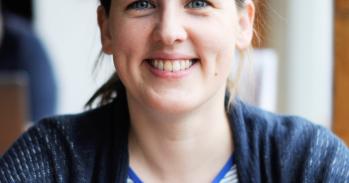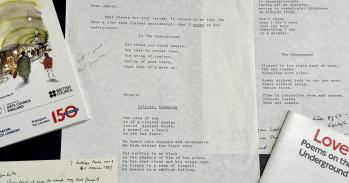
An archive of philosopher Ludwig Wittgenstein’s original work throws fresh light on the workings of a brilliant mind.
An archive of philosopher Ludwig Wittgenstein’s original work throws fresh light on the workings of a brilliant mind.
In effect, Wittgenstein is saying: also look for the unknown in the familiar. We should not indoctrinate ourselves with what is known as if it were imperious authority.
Professor Arthur Gibson
A hitherto unpublished archive left by the world famous philosopher Ludwig Wittgenstein, who died 60 years ago on 29 April 1951, is being edited at his Cambridge College for publication. It provides new insight into the workings of a brilliant mind and yields understanding of his complex relationships with friends and associates.
The archive, which comprises many different manuscripts, is being examined at Trinity College, Cambridge, where Wittgenstein was Senior Research Fellow and later Professor of Philosophy. It was given to the Mathematical Association (MA) in the 1970s by its former President, Professor Reuben Goodstein, who was a student of Wittgenstein.
Many of the manuscripts are in the handwriting of the Trinity mathematician Francis Skinner, who plays a leading role in the story of the archive, both as Wittgenstein’s friend and amanuensis (assistant and scribe). One of the most interesting manuscripts urges us to look for the unknown in the familiar as a means of unlocking new ways of thinking.
The MA asked Trinity College (the home of the largest surviving portion of Wittgenstein’s literary remains) to investigate the archive several years ago. The philosopher Professor Arthur Gibson, known for his own original work, was invited by the College to study the archive and, also with the permission of the MA, to prepare for the archive’s publication in book form.
Professor Gibson has strong links with Wittgenstein. As an undergraduate at Cambridge he was taught by two of the philosopher’s most distinguished students – Professors Elizabeth Anscombe and Peter Geach – who later became Wittgenstein’s editors. When Wittgenstein died Professor Anscombe was named as one of his literary heirs.
The archive unpacked
The archive comprises two boxes of manuscript books and papers. When Professor Gibson first opened the boxes, he was stunned by what lay before him. The two boxes contain a series of dictated lecture notes in Skinner’s handwriting with Wittgenstein’s own handwritten revisions and corrections. A series of exercise books contain a verbatim manuscript record of material dictated by Wittgenstein to Skinner with Wittgenstein’s later amendments. These consist of the work that is now known as the Brown Book, with a revised opening, some other changes, an additional 60 pages of manuscript, together with exercise books and papers containing dictation completely unknown to Wittgenstein scholars.
Also preserved is a charming Norwegian school exercise book with a sequential text, which appears to date from Wittgenstein’s stay in Norway in the late 1930s. Among the exercise books is one with a pinkish cover, containing a complete and unknown narrative with many visual illustrations. “This may or may not be the missing item called the Pink Book or Yellow Book that scholars have long been hoping for,” says Professor Gibson.
Among the documents on philosophy and logic is a series of mathematical calculations, which represents an exploration of Fermat’s Little Theorem. The many columns of figures, written in black ink on unlined paper, comprise a continuous calculation made on many sheets that once laid out stretch to some 20 feet in length. “It’s an extraordinary, even bizarre and yet original, series of calculations,” says Professor Gibson.
“It’s as if the writer, a bit like a computer, partially switched off his mind, and used his brain almost as a machine with a random disposition. It’s interesting to remember that the brilliant mathematician Alan Turing attended some of Wittgenstein’s lectures during the period before Turing’s major breakthrough. There is a huge amount to explore in terms of connections that can be made from the archive.”
The archive was composed in Wittgenstein’s “middle period”, when he was developing original concepts as well as teaching them. It had been assumed that Skinner was just one of a number of students taking notes in Wittgenstein’s lectures. Professor Gibson’s careful investigations of the contents of the archive reveal that Skinner was not only the philosopher’s chief amanuensis for this period, but also an in-house partner and co-editor – in other words far more important to Wittgenstein’s philosophy than previously thought.
“Skinner’s handwritten notes, in combination with revisions in Wittgenstein’s hand, together with alterations dictated to Skinner by Wittgenstein away from lectures, open a window onto Wittgenstein’s private thought processes and suggest an unusual unity between author and amanuensis. There is evidence of editing designed for book publication, yet also evidence of subsequent extensive re-writing and private re-composition. The discovery of the archive makes it apparent how very close Skinner was to Wittgenstein,” says Professor Gibson.
Professor Gibson has identified several over-arching themes in the archive. At the centre of these is the claim that the denial of self-evidence is at the heart of logic, some mathematics, philosophy, and deeper areas of science. He says: “The archive shows that unpredicted and new revolutionary matters still await us in Wittgenstein’s philosophy and scientific knowledge that we incorrectly think we already understand.”
An excerpt of the newly-discovered pink book explored
Professor Gibson says: “One manuscript page, which comes from the Wittgenstein pink book, is dated 22 November 1933. During this period Wittgenstein dictated and revised the Blue and Brown Books. A few remarks in this pink book were originally in one of the earliest handwritten unpublished drafts of Wittgenstein’s Blue book – now known to have been dictated to Skinner. This newly-found pink book appears to have been earmarked for separate publication; yet it never appeared.
“The two pages of the pink book pictured above have a paragraph on the left in Wittgenstein’s handwriting, with the material he dictated to Skinner in Skinner’s handwriting on the right. Often the two hands are blended together, which shows the intimacy of their work together. Even so, the remark in Wittgenstein’s hand is typical of his way of composing. Very often Wittgenstein is carefully and experimentally developing challenging dialogue with unnamed disputants whom he greatly appreciates. Perhaps in the case of the text pictured above it was Schopenhauer presupposing a form of Plato’s view. “
The text on the left-hand-side, written by Wittgenstein, in the midst of a complex analysis, reads as follows:
It is extremely interesting that very often when people say that science has not yet discovered this or that but if X will have discovered it then….., that they very often don’t know at all what sort of discovery they are waiting for, that they talk of a discovery without knowing of what nature this discovery would be. (For example when people say that one day when psychology will be far enough developed it will make us understand the nature of beauty.)
As Professor Gibson explains: “Wittgenstein’s position in the manuscript appears to be that even within elementary science, future unpredicted identities can emerge from within it that are quite unknown – they are not self-evident. Unfortunately many experts programme themselves as if this is not true. Consequently they block off their own true potential to discover new futures. In effect, Wittgenstein is saying: also look for the unknown in the familiar. We should not indoctrinate ourselves with what is known as if it were imperious authority. More to the point, this archive, as with many of his other writings, shows us to some degree how to achieve new thinking and action.”
Personal backstory
Born on 26 April 1889, Ludwig Wittgenstein is acknowledged to be a hugely influential philosopher whose work challenged much past and contemporary thought. Within his lifetime, his extensive written output was accompanied by very little formal publication of his philosophy, apart from his early book the Tractatus and a few short publications, including a book review, one article and a children’s dictionary. When he died he left more than four million words unpublished, including the path-breaking Philosophical Investigations, which was published in 1953.
Until recently it was thought that all longer manuscripts of any significance had been discovered. The archive currently being examined changes much of that. Its loss from the public eye was the result of the the tragic death at the age of 29 of Skinner, Wittgenstein’s pupil and close friend, and Wittgenstein’s grief.
“While there are outstanding published biographies of his life, the full and complex story of this aspect of his life surrounding the archive is yet fully to emerge – and it is fascinating from the points of view of both Wittgenstein’s private life and his contribution to philosophy,” says Professor Gibson.
Wittgenstein lived for some years with Skinner in Cambridge. As a child Skinner had been a victim of poliomyelitis and suffered recurrent attacks as an adult. One of these occurred on 3 October 1941. He was taken into the Cambridge Hospital for Infectious Diseases. Meanwhile, the nearby RAF Wellington base was being bombed and many victims were being brought into the same hospital. Skinner was left on a bed in a corridor. Later he was found to be dying of “Acute Anterior Poliomyelitis”, as his death certificate states, noting that Wittgenstein was present.
The devastation felt by Wittgenstein, who had fought for Austro-Hungary in World War I, as he sat at his friend’s bedside, can be imagined. He returned to Trinity in a state of nervous collapse and tried to resign his professorship. He then posted the archive now being examined at Trinity to his former student Reuben Goodstein. He too was also deeply affected by Skinner’s death; they had been close friends at their school, St Paul’s.
This work is licensed under a Creative Commons Licence. If you use this content on your site please link back to this page.





